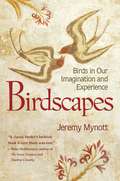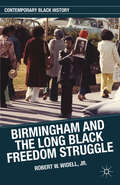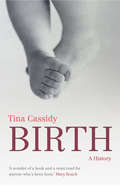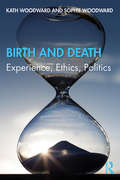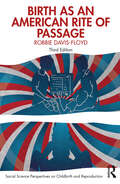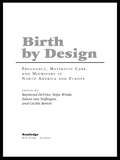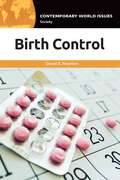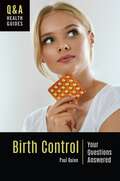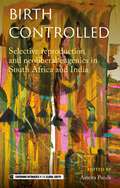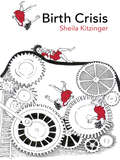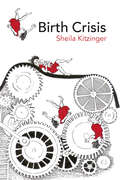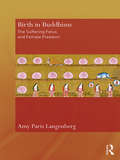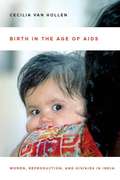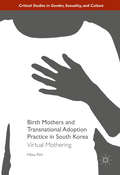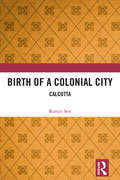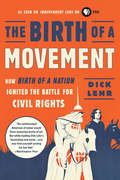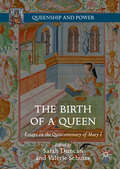- Table View
- List View
Birdscapes: Birds in Our Imagination and Experience (Princeton Shorts Ser.)
by Jeremy MynottWhat draws us to the beauty of a peacock, the flight of an eagle, or the song of a nightingale? Why are birds so significant in our lives and our sense of the world? And what do our ways of thinking about and experiencing birds tell us about ourselves? Birdscapes is a unique meditation on the variety of human responses to birds, from antiquity to today, and from casual observers to the globe-trotting "twitchers" who sometimes risk life, limb, and marriages simply to add new species to their "life lists." Drawing extensively on literature, history, philosophy, and science, Jeremy Mynott puts his own experiences as a birdwatcher in a rich cultural context. His sources range from the familiar--Thoreau, Keats, Darwin, and Audubon--to the unexpected--Benjamin Franklin, Giacomo Puccini, Oscar Wilde, and Monty Python. Just as unusual are the extensive illustrations, which explore our perceptions and representations of birds through images such as national emblems, women's hats, professional sports logos, and a Christmas biscuit tin, as well as classics of bird art. Each chapter takes up a new theme--from rarity, beauty, and sound to conservation, naming, and symbolism--and is set in a new place, as Mynott travels from his "home patch" in Suffolk, England, to his "away patch" in New York City's Central Park, as well as to Russia, Australia, and Greece. Conversational, playful, and witty, Birdscapes gently leads us to reflect on large questions about our relation to birds and the natural world. It encourages birders to see their pursuits in a broader human context--and it shows nonbirders what they may be missing.
Birmingham and the Long Black Freedom Struggle (Contemporary Black History)
by Robert W. Widell, Jr.Birmingham, Alabama looms large in the history of the twentieth-century black freedom struggle, but to date historians have mostly neglected the years after 1963. Here, author Robert Widell explores the evolution of Birmingham black activism into the 1970s, providing a valuable local perspective on the "long" black freedom struggle.
Birth: A History
by Tina CassidyThe engaging and eye-opening story of how we and our ancestors entered the world.Through the frigid, blurry January weeks after George was born, I found myself suddenly housebound with time to ruminate - though not time to cook or take a shower. When George was peaceful, my mind returned to that nagging question: why is birth so hit and miss after all this time? I needed to put into perspective my own experience. I needed to know what other women, in other cultures, in other times had done.Birth is a book that will open the eyes of even the most informed experts on the subject. Cassidy looks at every aspect of childbirth - from fathers and mothers to doctors and widwives across the centuries - with admirable objectivity in a work that is utterly gripping, occasionally shocking and essential reading for the human race.
Birth and Death: Experience, Ethics, Politics
by Kath Woodward Sophie WoodwardUsually conceived in opposition to each other – birth as a hopeful beginning, death as an ending – this book brings them into dialogue with each other to argue that both are central to our experiences of being in the world and part of living. Written by two authors, this book takes an intergenerational approach to highlight the connections and disconnections between birth and death; adopting a relational approach allows the book to explore birth and death through the key relationships that constitute them: personal and social, private and public, the affective and social norms, the actual and the virtual and the ordinary and profound. Of interest to academics and students in the fields of feminism, phenomenology and the life course, the book will also be of relevance to policy makers in the areas of birth activism and end of life care. Drawing from personal stories, everyday life and publicly contested examples, the book will also be of interest to a more general readership as it engages with questions we all at some point will grapple with.
Birth and Death: Experience, Ethics, Politics
by Kath Woodward Sophie WoodwardUsually conceived in opposition to each other – birth as a hopeful beginning, death as an ending – this book brings them into dialogue with each other to argue that both are central to our experiences of being in the world and part of living. Written by two authors, this book takes an intergenerational approach to highlight the connections and disconnections between birth and death; adopting a relational approach allows the book to explore birth and death through the key relationships that constitute them: personal and social, private and public, the affective and social norms, the actual and the virtual and the ordinary and profound. Of interest to academics and students in the fields of feminism, phenomenology and the life course, the book will also be of relevance to policy makers in the areas of birth activism and end of life care. Drawing from personal stories, everyday life and publicly contested examples, the book will also be of interest to a more general readership as it engages with questions we all at some point will grapple with.
Birth as an American Rite of Passage (Social Science Perspectives on Childbirth and Reproduction)
by Robbie Davis-FloydThis classic book, first published in 1992 and again in 2003, has inspired three generations of childbearing people, birth activists and researchers, and birth practitioners—midwives, doulas, nurses, and obstetricians—to take a fresh look at the "standard procedures" that are routinely used to "manage" American childbirth. It was the first book to identify these non-evidence-based obstetric interventions as rituals that enact and transmit the core values of the American technocracy, thereby answering the pressing question of why these interventions continue to be performed despite all evidence to the contrary. This third edition brings together Davis-Floyd's insights into the intense ritualization of labor and birth and the technocratic, humanistic, and holistic models of birth with new data collected in recent years.
Birth as an American Rite of Passage (Social Science Perspectives on Childbirth and Reproduction)
by Robbie Davis-FloydThis classic book, first published in 1992 and again in 2003, has inspired three generations of childbearing people, birth activists and researchers, and birth practitioners—midwives, doulas, nurses, and obstetricians—to take a fresh look at the "standard procedures" that are routinely used to "manage" American childbirth. It was the first book to identify these non-evidence-based obstetric interventions as rituals that enact and transmit the core values of the American technocracy, thereby answering the pressing question of why these interventions continue to be performed despite all evidence to the contrary. This third edition brings together Davis-Floyd's insights into the intense ritualization of labor and birth and the technocratic, humanistic, and holistic models of birth with new data collected in recent years.
Birth By Design: Pregnancy, Maternity Care and Midwifery in North America and Europe
by Raymond DeVries Sirpa Wrede Edwin Van Teijlingen Cecilia BenoitFirst published in 2001. Routledge is an imprint of Taylor & Francis, an informa company.
Birth By Design: Pregnancy, Maternity Care and Midwifery in North America and Europe
by Raymond De Vries Cecilia Benoit Edwin Van Teijlingen Sirpa WredeFirst published in 2001. Routledge is an imprint of Taylor & Francis, an informa company.
Birth Control: A Reference Handbook (Contemporary World Issues)
by David E. NewtonBirth Control: A Reference Handbook provides a breadth and depth of discussion about birth control throughout human history and in the modern day, with attention paid to the controversies related to it.Birth Control: A Reference Handbook covers the topic of birth control from the earliest pages of human history to the present day. The book is divided into two parts. The first two chapters provide a historical background to the topic and a review of current issues and problems. The remainder of the book consists of chapters that aid the reader in continuing her or his own research on the topic, such as an extended annotated bibliography, chronology, glossary, noteworthy individuals and organizations in the field, and important data and documents.This book differs from other works on its subject primarily because of the variety of resources provided, such as further reading, perspective essays on the topic, a historical timeline, and useful terms in the field. It is intended for readers of high school through the community college level, along with adult readers who may be interested in the topic.
Birth Control: A Reference Handbook (Contemporary World Issues)
by David E. NewtonBirth Control: A Reference Handbook provides a breadth and depth of discussion about birth control throughout human history and in the modern day, with attention paid to the controversies related to it.Birth Control: A Reference Handbook covers the topic of birth control from the earliest pages of human history to the present day. The book is divided into two parts. The first two chapters provide a historical background to the topic and a review of current issues and problems. The remainder of the book consists of chapters that aid the reader in continuing her or his own research on the topic, such as an extended annotated bibliography, chronology, glossary, noteworthy individuals and organizations in the field, and important data and documents.This book differs from other works on its subject primarily because of the variety of resources provided, such as further reading, perspective essays on the topic, a historical timeline, and useful terms in the field. It is intended for readers of high school through the community college level, along with adult readers who may be interested in the topic.
Birth Control: Your Questions Answered (Q&A Health Guides)
by Paul QuinnThis book will serve as a scientifically accurate yet easy-to-read introduction to birth control for teens and young adults. The information, guidance, and resources it offers will help readers to make better decisions regarding their sexual health.From barrier methods such as condoms and diaphragms to oral contraceptive pills and from hormone-based implants and injectables to permanent sterilization techniques, there are a number of ways to prevent unwanted pregnancy today. But which are the most effective, and how do you choose the method that's right for you? What about side effects and long-term implications for health, such as increased risk for cancer? Does birth control affect your chances of getting pregnant in the future? Birth Control: Your Questions Answered, a part of Greenwood's Q&A Health Guides series, provides clear, concise answers to these and other questions young readers may have about this sometimes embarrassing, yet very important, topic. Each book in this series follows a reader-friendly question-and-answer format that anticipates readers' needs and concerns. Prevalent myths and misconceptions are identified and dispelled, and a collection of case studies illustrates key concepts and issues through relatable stories and insightful recommendations. The book also includes a section on health literacy, equipping teens and young adults with practical tools and strategies for finding, evaluating, and using credible sources of health information both on and off the internet—important skills that contribute to a lifetime of healthy decision-making.
Birth Control: Your Questions Answered (Q&A Health Guides)
by Paul QuinnThis book will serve as a scientifically accurate yet easy-to-read introduction to birth control for teens and young adults. The information, guidance, and resources it offers will help readers to make better decisions regarding their sexual health.From barrier methods such as condoms and diaphragms to oral contraceptive pills and from hormone-based implants and injectables to permanent sterilization techniques, there are a number of ways to prevent unwanted pregnancy today. But which are the most effective, and how do you choose the method that's right for you? What about side effects and long-term implications for health, such as increased risk for cancer? Does birth control affect your chances of getting pregnant in the future? Birth Control: Your Questions Answered, a part of Greenwood's Q&A Health Guides series, provides clear, concise answers to these and other questions young readers may have about this sometimes embarrassing, yet very important, topic. Each book in this series follows a reader-friendly question-and-answer format that anticipates readers' needs and concerns. Prevalent myths and misconceptions are identified and dispelled, and a collection of case studies illustrates key concepts and issues through relatable stories and insightful recommendations. The book also includes a section on health literacy, equipping teens and young adults with practical tools and strategies for finding, evaluating, and using credible sources of health information both on and off the internet—important skills that contribute to a lifetime of healthy decision-making.
Birth controlled: Selective reproduction and neoliberal eugenics in South Africa and India (Governing Intimacies in the Global South)
by Amrita PandeBirth controlled analyses the world of selective reproduction – the politics of who gets to legitimately reproduce the future – through a cross-cultural analysis of three modes of ‘controlling’ birth: contraception, reproductive violence and repro-genetic technologies. It argues that as fertility rates decline worldwide, the fervour to control fertility, and fertile bodies, does not dissipate; what evolves is the preferred mode of control. Although new technologies like those that assist conception or allow genetic selection may appear to be an antithesis of other violent versions of population control, this book demonstrates that both are part of the same continuum. All population control policies target and vilify women (Black women in particular), and coerce them into subjecting their bodies to state and medical surveillance; Birth controlled argues that assisted reproductive technologies and repro-genetic technologies employ a similar and stratified burden of blame and responsibility based on gender, race, class and caste. To empirically and historically ground the analysis, the book includes contributions from two postcolonial nations, South Africa and India, examining interactions between the history of colonialism and the economics of neoliberal markets and their influence on the technologies and politics of selective reproduction.The book provides a critical, interdisciplinary and cutting-edge dialogue around the interconnected issues that shape reproductive politics in an ostensibly ‘post-population control’ era. The contributions draw on a breadth of disciplines ranging from gender studies, sociology, medical anthropology, politics and science and technology studies to theology, public health and epidemiology, facilitating an interdisciplinary dialogue around the interconnected modes of controlling birth and practices of neo-eugenics.
Birth controlled: Selective reproduction and neoliberal eugenics in South Africa and India (Governing Intimacies in the Global South)
by Amrita PandeBirth controlled analyses the world of selective reproduction – the politics of who gets to legitimately reproduce the future – through a cross-cultural analysis of three modes of ‘controlling’ birth: contraception, reproductive violence and repro-genetic technologies. It argues that as fertility rates decline worldwide, the fervour to control fertility, and fertile bodies, does not dissipate; what evolves is the preferred mode of control. Although new technologies like those that assist conception or allow genetic selection may appear to be an antithesis of other violent versions of population control, this book demonstrates that both are part of the same continuum. All population control policies target and vilify women (Black women in particular), and coerce them into subjecting their bodies to state and medical surveillance; Birth controlled argues that assisted reproductive technologies and repro-genetic technologies employ a similar and stratified burden of blame and responsibility based on gender, race, class and caste. To empirically and historically ground the analysis, the book includes contributions from two postcolonial nations, South Africa and India, examining interactions between the history of colonialism and the economics of neoliberal markets and their influence on the technologies and politics of selective reproduction.The book provides a critical, interdisciplinary and cutting-edge dialogue around the interconnected issues that shape reproductive politics in an ostensibly ‘post-population control’ era. The contributions draw on a breadth of disciplines ranging from gender studies, sociology, medical anthropology, politics and science and technology studies to theology, public health and epidemiology, facilitating an interdisciplinary dialogue around the interconnected modes of controlling birth and practices of neo-eugenics.
Birth Crisis
by Sheila KitzingerOne new mother in twenty is diagnosed with traumatic stress after childbirth. In Birth Crisis Sheila Kitzinger explores the disempowerment and anxiety experienced by these women. Key topics discussed include: increasing intervention in pregnancy the shift in emphasis from relationships to technology in childbirth how family, friends and professional caregivers can reach out to traumatized mothers how women can work through stress to understand themselves more deeply and grow in emotional maturity how care and the medical system needs to be changed. Birth Crisis draws on mothers' voices and real-life experiences to explore the suffering after childbirth which has, until now, been brushed under the carpet. It is a fascinating and useful resource for student and practising midwives, all health professionals, and women and their families who want to learn how to overcome a traumatic birth.
Birth Crisis
by Sheila KitzingerOne new mother in twenty is diagnosed with traumatic stress after childbirth. In Birth Crisis Sheila Kitzinger explores the disempowerment and anxiety experienced by these women. Key topics discussed include: increasing intervention in pregnancy the shift in emphasis from relationships to technology in childbirth how family, friends and professional caregivers can reach out to traumatized mothers how women can work through stress to understand themselves more deeply and grow in emotional maturity how care and the medical system needs to be changed. Birth Crisis draws on mothers' voices and real-life experiences to explore the suffering after childbirth which has, until now, been brushed under the carpet. It is a fascinating and useful resource for student and practising midwives, all health professionals, and women and their families who want to learn how to overcome a traumatic birth.
Birth in Buddhism: The Suffering Fetus and Female Freedom (Routledge Critical Studies in Buddhism)
by Amy Paris LangenbergRecent decades have seen a groundswell in the Buddhist world, a transnational agitation for better opportunities for Buddhist women. Many of the main players in the transnational nuns movement self-identify as feminists but other participants in this movement may not know or use the language of feminism. In fact, many ordained Buddhist women say they seek higher ordination so that they might be better Buddhist practitioners, not for the sake of gender equality. Eschewing the backward projection of secular liberal feminist categories, this book describes the basic features of the Buddhist discourse of the female body, held more or less in common across sectarian lines, and still pertinent to ordained Buddhist women today. The textual focus of the study is an early-first-millennium Sanskrit Buddhist work, "Descent into the Womb scripture" or Garbhāvakrānti-sūtra. Drawing out the implications of this text, the author offers innovative arguments about the significance of childbirth and fertility in Buddhism, namely that birth is a master metaphor in Indian Buddhism; that Buddhist gender constructions are centrally shaped by Buddhist birth discourse; and that, by undermining the religious importance of female fertility, the Buddhist construction of an inauspicious, chronically impure, and disgusting femininity constituted a portal to a new, liberated, feminine life for Buddhist monastic women. Thus, this study of the Buddhist discourse of birth is also a genealogy of gender in middle period Indian Buddhism. Offering a new critical perspective on the issues of gender, bodies and suffering, this book will be of interest to an interdisciplinary audience, including researchers in the field of Buddhism, South Asian history and religion, gender and religion, theory and method in the study of religion, and Buddhist medicine.
Birth in Buddhism: The Suffering Fetus and Female Freedom (Routledge Critical Studies in Buddhism)
by Amy Paris LangenbergRecent decades have seen a groundswell in the Buddhist world, a transnational agitation for better opportunities for Buddhist women. Many of the main players in the transnational nuns movement self-identify as feminists but other participants in this movement may not know or use the language of feminism. In fact, many ordained Buddhist women say they seek higher ordination so that they might be better Buddhist practitioners, not for the sake of gender equality. Eschewing the backward projection of secular liberal feminist categories, this book describes the basic features of the Buddhist discourse of the female body, held more or less in common across sectarian lines, and still pertinent to ordained Buddhist women today. The textual focus of the study is an early-first-millennium Sanskrit Buddhist work, "Descent into the Womb scripture" or Garbhāvakrānti-sūtra. Drawing out the implications of this text, the author offers innovative arguments about the significance of childbirth and fertility in Buddhism, namely that birth is a master metaphor in Indian Buddhism; that Buddhist gender constructions are centrally shaped by Buddhist birth discourse; and that, by undermining the religious importance of female fertility, the Buddhist construction of an inauspicious, chronically impure, and disgusting femininity constituted a portal to a new, liberated, feminine life for Buddhist monastic women. Thus, this study of the Buddhist discourse of birth is also a genealogy of gender in middle period Indian Buddhism. Offering a new critical perspective on the issues of gender, bodies and suffering, this book will be of interest to an interdisciplinary audience, including researchers in the field of Buddhism, South Asian history and religion, gender and religion, theory and method in the study of religion, and Buddhist medicine.
Birth in the Age of AIDS: Women, Reproduction, and HIV/AIDS in India
by Cecilia Van HollenBirth in the Age of AIDS is a vivid and poignant portrayal of the experiences of HIV-positive women in India during pregnancy, birth, and motherhood at the beginning of the 21st century. The government of India, together with global health organizations, established an important public health initiative to prevent HIV transmission from mother to child. While this program, which targets poor women attending public maternity hospitals, has improved health outcomes for infants, it has resulted in sometimes devastatingly negative consequences for poor, young mothers because these women are being tested for HIV in far greater numbers than their male spouses and are often blamed for bringing this highly stigmatized disease into the family. Based on research conducted by the author in India, this book chronicles the experiences of women from the point of their decisions about whether to accept HIV testing, through their decisions about whether or not to continue with the birth if they test HIV-positive, their birthing experiences in hospitals, decisions and practices surrounding breast-feeding vs. bottle-feeding, and their hopes and fears for the future of their children.
Birth Mothers and Transnational Adoption Practice in South Korea: Virtual Mothering (Critical Studies in Gender, Sexuality, and Culture)
by Hosu KimThis book illuminates the hidden history of South Korean birth mothers involved in the 60-year-long practice of transnational adoption. The author presents a performance-based ethnography of maternity homes, a television search show, an internet forum, and an oral history collection to develop the concept of virtual mothering, a theoretical framework in which the birth mothers' experiences of separating from, and then reconnecting with, the child, as well as their painful,ambivalent narratives of adoption losses, are rendered, felt and registered. In this, the author refuses a universal notion of motherhood. Her critique of transnational adoption and its relentless effects on birth mothers’ lives points to the everyday, normalized, gendered violence against working-class, poor, single mothers in South Korea’s modern nation-state development and illuminates the biopolitical functions of transnational adoption in managing an "excess" population. Simultaneously, her creative analysis reveals a counter-public, and counter-history, proposing the collective grievances of birth mothers.
Birth of a Colonial City: Calcutta
by Ranjit SenLong before Calcutta was ‘discovered’ by Job Charnock, it thrived by the Hugli since times immemorial. This book, and its companion Colonial Calcutta, is a biographical account of the when, the how and the what of a global city and its emergence under colonial rule in the 1800s. Ranjit Sen traces the story of how three clustered villages became the hub of the British Empire and a centre of colonial imagination. He examines the historical and geopolitical factors that were significant in securing its prominence, and its subsequent urbanization which was a colonial experience without an antecedent. Further, it sheds light on Calcutta’s early search for identity — how it superseded interior towns and flourished as the seat of power for its hinterland; developed its early institutions, while its municipal administration slowly burgeoned. A sharp analysis of the colonial enterprise, this volume lays bare the underbelly of the British Raj. It will be of great interest to scholars and researchers of modern history, South Asian history, urban studies, British Studies and area studies.
Birth of a Colonial City: Calcutta
by Ranjit SenLong before Calcutta was ‘discovered’ by Job Charnock, it thrived by the Hugli since times immemorial. This book, and its companion Colonial Calcutta, is a biographical account of the when, the how and the what of a global city and its emergence under colonial rule in the 1800s. Ranjit Sen traces the story of how three clustered villages became the hub of the British Empire and a centre of colonial imagination. He examines the historical and geopolitical factors that were significant in securing its prominence, and its subsequent urbanization which was a colonial experience without an antecedent. Further, it sheds light on Calcutta’s early search for identity — how it superseded interior towns and flourished as the seat of power for its hinterland; developed its early institutions, while its municipal administration slowly burgeoned. A sharp analysis of the colonial enterprise, this volume lays bare the underbelly of the British Raj. It will be of great interest to scholars and researchers of modern history, South Asian history, urban studies, British Studies and area studies.
The Birth of a Movement: How Birth of a Nation Ignited the Battle for Civil Rights
by Dick LehrAt the dawn of the modern civil rights movement, Monroe Trotter, a journalist agitator, and D.W. Griffith, a technically brilliant filmmaker, incited a public confrontation that roiled America, pitting black against white, Hollywood against Boston, and free speech against the fight for equality.Monroe Trotter and D. W. Griffith were fighting over a film that dramatized the Civil War and Reconstruction in a post-Confederate South. Griffith's film, The Birth of a Nation, included actors in blackface, heroic portraits of Knights of the Ku Klux Klan, and a depiction of Lincoln's assassination. Freed slaves were portrayed as villainous, vengeful, slovenly, and dangerous to the sanctity of American values. It was tremendously successful, eventually seen by 25 million Americans. But violent protests against the film flared up across the country.Almost fifty years earlier, Monroe's father, James, was a sergeant in an all-black Union regiment that marched into Charleston, South Carolina, just as the Kentucky cavalry-including Roaring Jack Griffith, D. W.'s father-fled for their lives. Monroe Trotter's titanic crusade to have the film censored became a blueprint for dissent during the 1950s and 1960s. This is the fiery story of a revolutionary moment for mass media and the nascent civil rights movement, and the men clashing over the cultural and political soul of a still-young America standing at the cusp of its greatest days.
The Birth of a Queen: Essays on the Quincentenary of Mary I (Queenship and Power)
by Sarah Duncan Valerie SchutteMarking the 500th year anniversary of the birth of Queen Mary I in 1516, this book both commemorates her rule and rehabilitates and redefines her image and reign as England's first queen regnant. In this broad collection of essays, leading historians of queenship (or monarchy) explore aspects of Mary's life from birth to reign to death and cultural afterlife, giving consideration to the struggles she faced both before and after her accession, and celebrating Mary as a queen in her own right.
